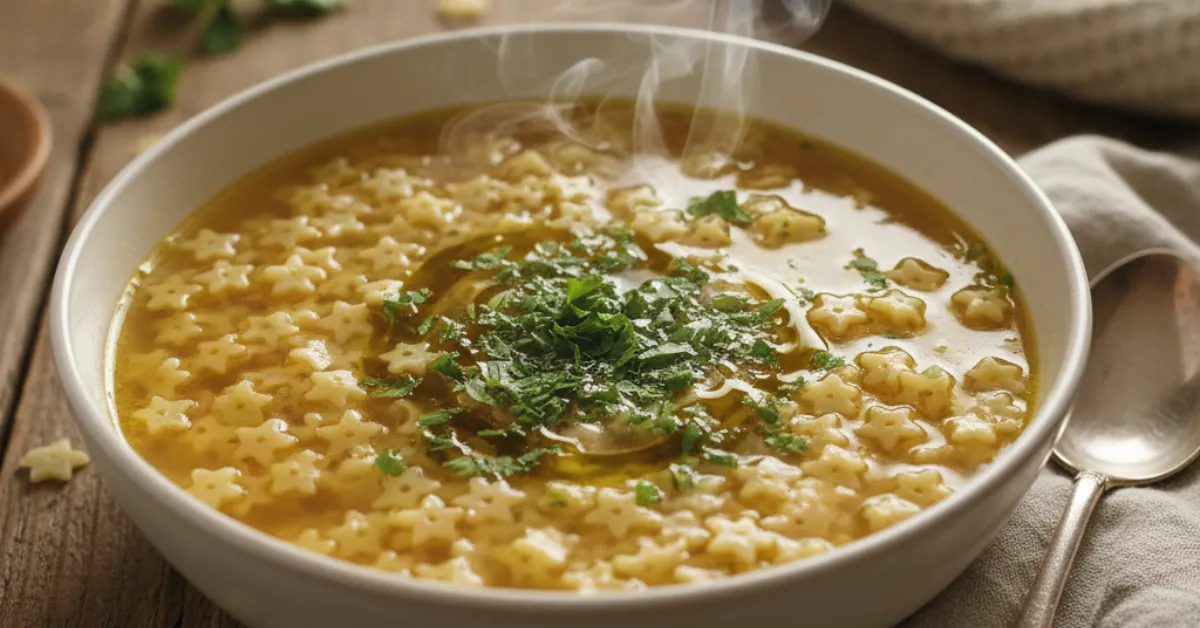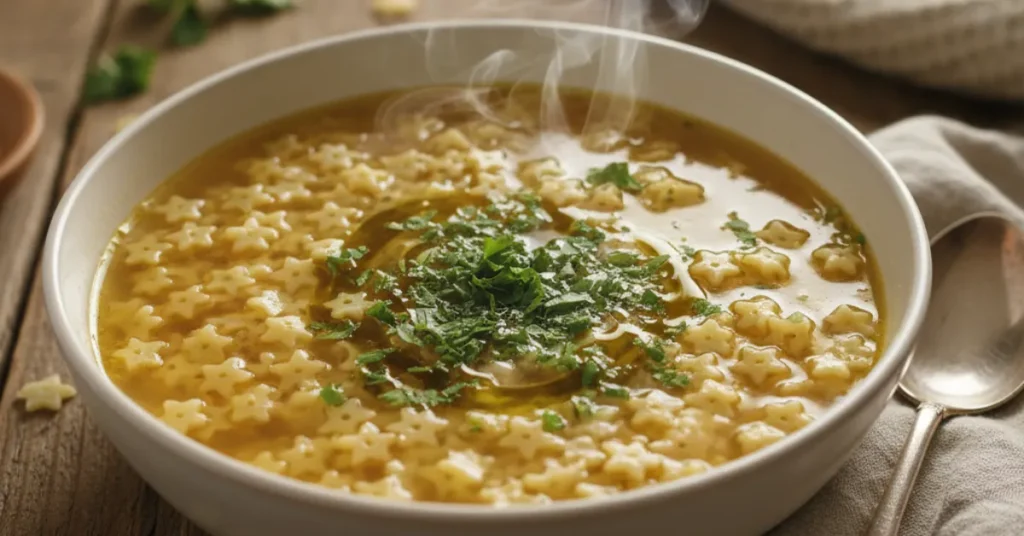
There are very few dishes as universally comforting as a bowl of **pastina soup**. Often referred to as “Italian penicillin,” this simple yet soulful dish is the remedy of choice for everything from a common cold to a low-energy day. It is the food of nonnas, a recipe passed down through generations, and a true testament to the power of uncomplicated, nourishing ingredients.
This **pastina soup recipe** relies on just a handful of ingredients to create a broth so rich and a texture so tender it feels like a warm embrace. While many versions of this tiny pasta dish exist—some with vegetables, some without—this guide focuses on the classic, traditional preparation. This is the **best pastina soup** you will ever make, perfect for when you need a moment of warmth and simplicity. The key is in the high-quality broth and the final luxurious additions.
Whether you are feeling under the weather or simply seeking a simple, delicious weeknight meal, learning how to make this authentic **Italian pastina soup** is an essential skill. Let’s dive into the details of this truly **miraculous** and easy recipe.
Why You’ll Love This Recipe
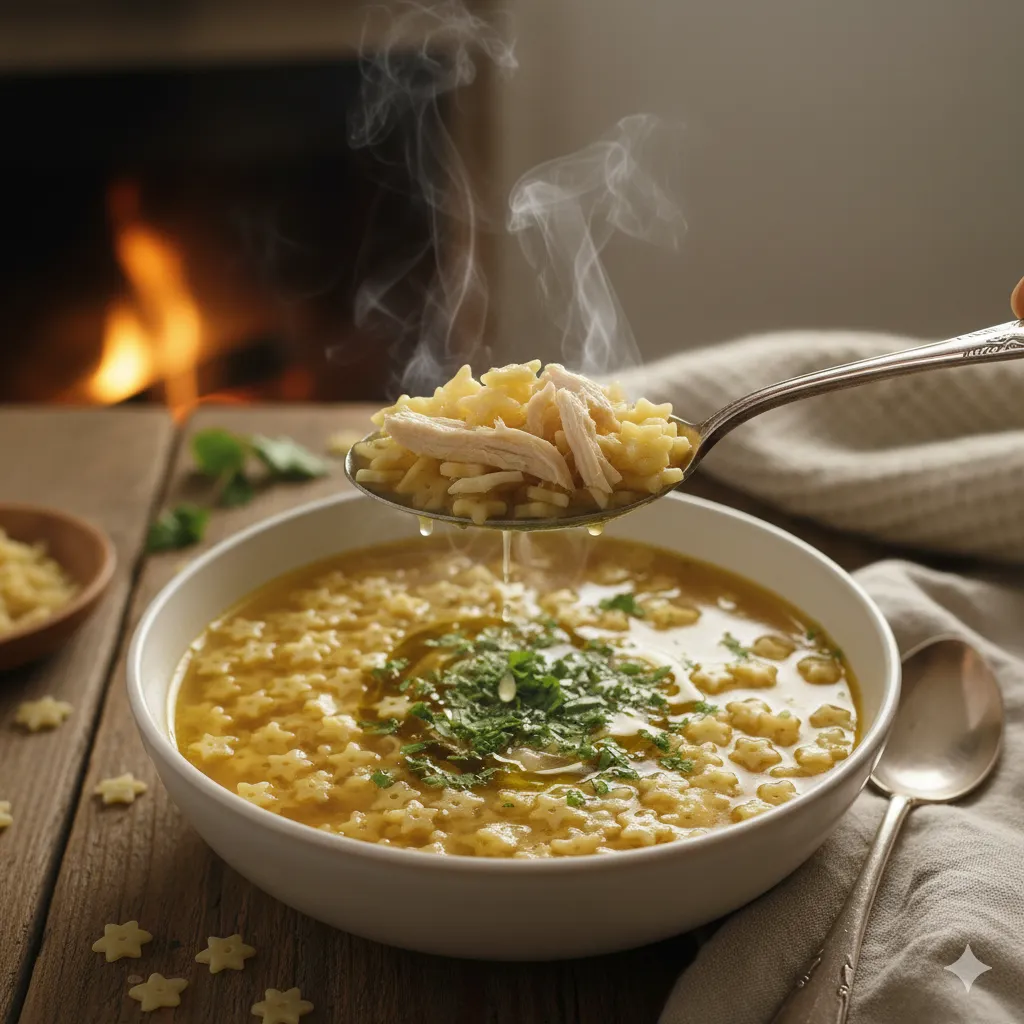
- **Quick Comfort:** You can have a bowl of this **pastina soup** ready in less than 20 minutes. It’s a quick and reliable recipe.
- **Simple Ingredients:** The magic of the dish is in its minimalism. You likely have everything you need in your pantry right now.
- **Soul-Soothing Flavor:** The combination of a high-quality broth and Parmesan cheese creates a deeply satisfying, savory flavor profile.
- **Authentic Italian Feel:** This is the authentic **Italian pastina soup** style, often prescribed by Italian grandmothers for ailments.
Ingredients
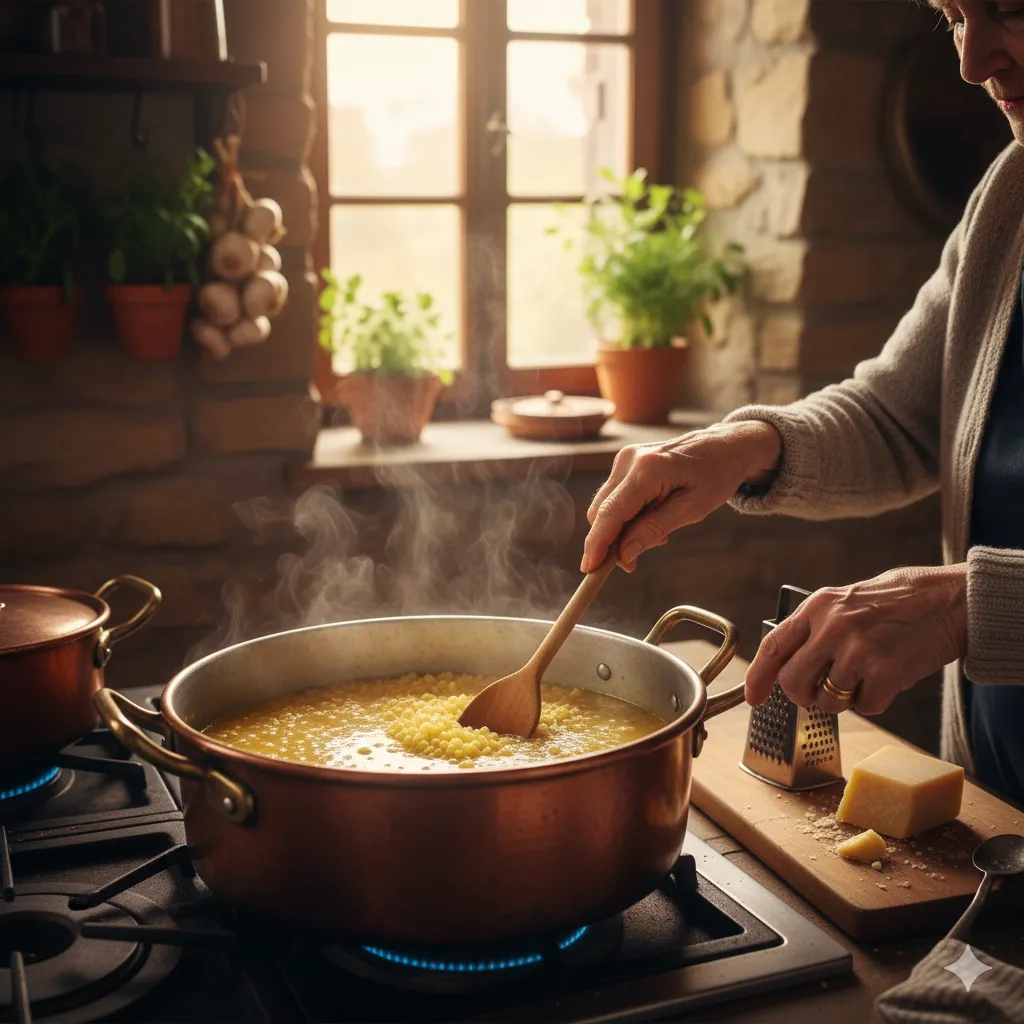
Achieving a great flavor starts with using high-quality ingredients for your **pastina soup recipe**. Since there are so few components, focus on the best broth you can find.
For the Best Soup:
- **Broth:** Use high-quality chicken or vegetable broth. Homemade is always superior, but a good quality boxed stock will work wonderfully for this recipe.
- **Pastina:** These tiny pasta shapes—often stars (Stelline) or small beads (Acini di Pepe)—are the heart of the dish.
- **Butter:** A small amount of unsalted butter adds richness and depth to the final flavor.
- **Parmesan Cheese:** Freshly grated is crucial. The quality of the cheese will define the final taste of this **pastina soup**.
- **Egg (Optional):** Many classic recipes incorporate a beaten egg for a thicker, creamier, and more protein-rich broth, reminiscent of Stracciatella.
Instructions
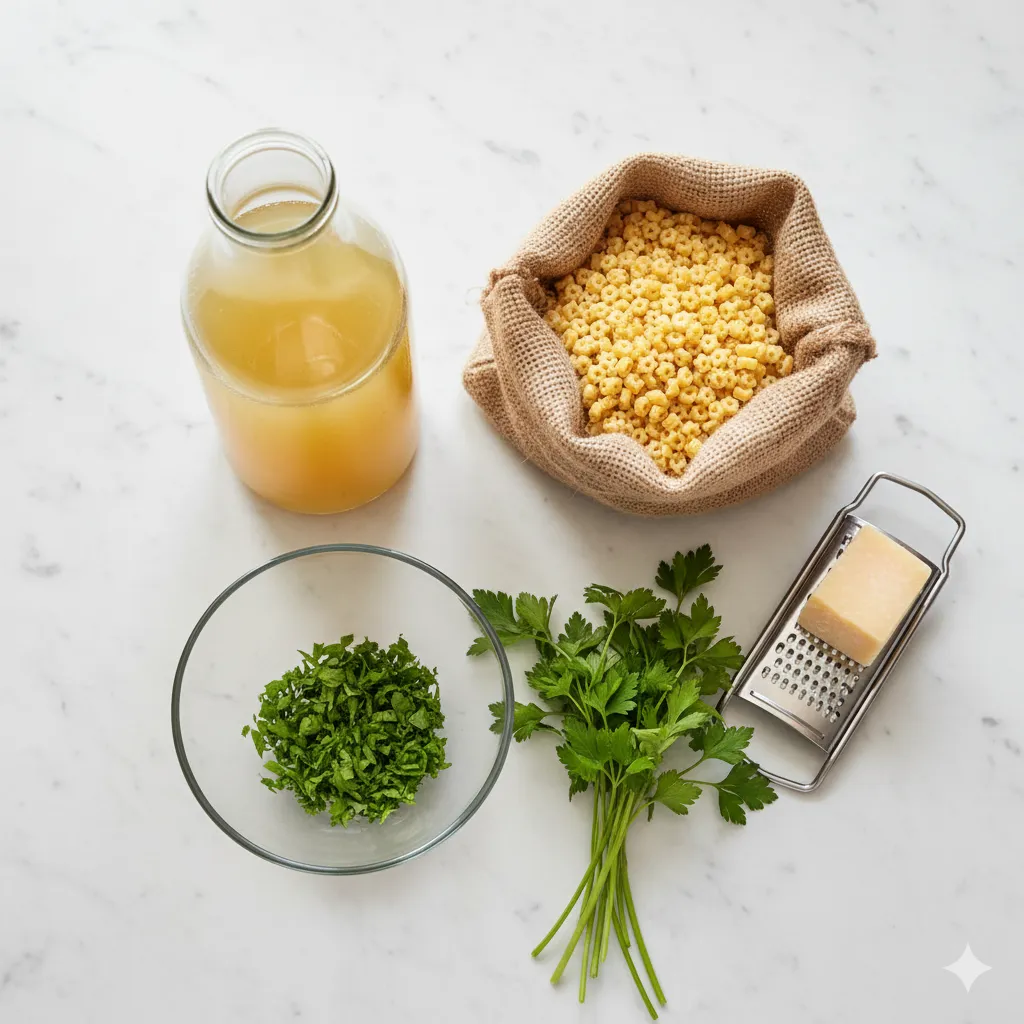
1. Simmer the Broth:
In a medium saucepan, bring 4 cups of your chosen broth (chicken or vegetable) to a gentle boil over medium-high heat. Reduce the heat to maintain a steady simmer. This slow simmer helps deepen the final flavor.
2. Cook the Pasta:
Add the pastina (about 1/2 cup) directly to the simmering broth. Cook according to package directions, usually 6 to 8 minutes. You want the tiny pasta to be cooked through but still have a pleasant chew (al dente). Stir occasionally to prevent sticking. Remember, the pasta will continue to absorb liquid as the **pastina soup** cools.
3. Temper the Egg (Optional):
If using the egg variation, beat one large egg in a small bowl. Before adding, scoop out a ladleful of the hot broth and slowly whisk it into the egg. This “tempers” the egg, preventing it from scrambling when it hits the hot pot. Immediately pour the tempered egg mixture into the pot while continuously stirring the soup vigorously for about 30 seconds until the egg is incorporated and the liquid thickens slightly.
4. Finish and Serve:
Remove the pot from the heat. Stir in the unsalted butter and about half of the grated Parmesan cheese until melted and smooth. Ladle the hot soup into bowls. Serve immediately with a generous final sprinkle of fresh Parmesan cheese and a dash of freshly ground black pepper. This is the quintessential way to enjoy this comforting dish.
You Must Know
The concept of “Italian Penicillin” is not a formal recipe but a cherished tradition rooted in using highly digestible, simple, and warm foods to aid recovery. This soup is ideal because it is easy on the stomach, providing comforting warmth and gentle energy without requiring a lot of digestive effort. The small size of the pastina is key; it’s manageable even for those with a sore throat or low appetite. The starch from the pastina thickens the broth naturally, which is why your homemade **pastina soup** often tastes richer and silkier than many store-bought varieties. The simplicity of the dish is a defining characteristic, and as pasta experts confirm, it is a staple for comfort and nostalgia.
One common pitfall with any **pastina soup recipe** is overcooking. Pastina absorbs liquid quickly and can turn from a comforting soup to a thick porridge in minutes. If you plan to make a large batch ahead of time, it is highly recommended that you cook the pastina separately and add it to the broth just before serving. This prevents the pasta from swelling too much. For other comforting home recipes, you can also explore our savory 3 Ingredient Biscuit Recipe. However, for sheer nostalgia, nothing beats a classic bowl of this Italian comfort.
The tradition often calls for mixing the finished soup with an egg yolk (instead of a whole, beaten egg) for an even richer, custardy texture. This is a matter of personal preference when creating your own simple, **miraculous pastina soup**.
Storage Tips
This dish is always best served immediately. The pastina will continue to absorb the broth as it sits, leading to a much thicker consistency upon reheating.
If you have leftovers, store the leftover soup in an airtight container in the refrigerator for up to 3 days. To reheat, you may need to add an extra splash of broth or water to thin the mixture back to a soup consistency. Always taste and adjust the seasoning after adding the extra liquid.
Ingredient Substitutions and Variations
This simple **pastina soup recipe** is highly adaptable to your pantry and taste preferences.
- **Vegan/Vegetarian:** Simply use a high-quality vegetable broth and substitute the Parmesan cheese with a vegan cheese alternative or a tablespoon of nutritional yeast for a cheesy, savory flavor.
- **Add Protein (Chicken Pastina Soup):** For a heartier meal, transform this into a **chicken pastina soup** by adding shredded rotisserie chicken or boiled chicken breast during the final minutes of cooking. This popular variation makes it a more substantial meal.
- **Herbs:** Finish the soup with fresh parsley, chives, or a hint of dried Italian seasoning for a different aromatic profile.
- **Add Vegetables:** For a slightly healthier twist, add a handful of finely chopped spinach, baby kale, or grated carrots during the last 3 minutes of simmering.
- **Dessert Pairing:** If you’re looking for other simple recipes to follow your soup, our rich and moist Banana Bread Recipe With Sour Cream is a perfect, comforting dessert complement.
Serving Suggestions
While often a meal in itself, this easy dish also pairs well with simple sides.
- **Bread:** Serve it with a crusty slice of Italian bread for dipping.
- **Side Salad:** A light, peppery arugula salad dressed with a simple lemon vinaigrette provides a nice contrast to the warm, rich flavors.
- **Sandwich:** For a classic comfort pairing, serve a small bowl of **Italian pastina soup** alongside a simple grilled cheese sandwich.
Cultural and Historical Notes
The term “pastina” itself simply means “little pasta.” While there are many shapes, the star shape (stelline) is perhaps the most iconic and associated with childhood and comfort. This tiny pasta’s popularity as a restorative food, particularly in times of illness, is a powerful example of how simple, accessible food can become cultural medicine. The simplicity of the **pastina soup recipe** is what gives it its enduring charm. This soup remains a symbol of nostalgia for many Italian-American families, connecting them to generations of kitchen wisdom.
Seasonal Adaptations
This dish is generally a fall and winter staple, but can be adapted for year-round enjoyment.
- **Cooler Months:** Use a heavier, richer bone broth and incorporate a little bit of root vegetable, such as finely diced celery or parsnip, into the liquid base.
- **Warmer Months:** Lighten the broth by diluting it slightly with water and finishing the soup with a generous amount of fresh lemon zest and juice. This transforms the rich flavor of the traditional recipe into a brighter, summery dish.
Three Helpful Notes about This Recipe
- **Salt Content:** Broths can vary widely in sodium. Wait until the very end, after adding the Parmesan cheese, to adjust the salt content. The cheese is salty and may provide all the necessary seasoning for your bowl.
- **Serving Vessel:** Serve in small, deep bowls. The intimate size of the vessel enhances the feeling of warmth and comfort associated with this **pastina soup recipe**.
- **Don’t Over-Stir:** Once the pastina is in, stir just enough to prevent sticking. Too much stirring can break the delicate pasta shapes and make the liquid too starchy. The final product should be a clear, comforting broth, not a thick porridge.
Success Stories
Countless anecdotes from across the globe testify to the restorative power of this simple recipe. From being the only thing an ailing child would consume to acting as a savory starter for holiday meals, the traditional preparation consistently delivers on comfort. Its uncomplicated nature ensures success for beginner cooks, while the depth of flavor keeps experienced chefs coming back to this simple staple. This truly is the **best pastina soup** you could hope to prepare.
Freezer Meal Conversion
You should only freeze the broth, not the cooked pasta. Cooked pastina will turn mushy and absorb all the liquid upon thawing. To prepare ahead, make a large batch of seasoned broth (including any vegetables or shredded meat for a **chicken pastina soup** variation). Freeze the broth in individual containers. When ready to eat, simply thaw the broth, bring it to a boil, and cook the pastina directly in the thawed broth for a quick, fresh bowl.
Pro Tips
- **Ghee for Flavor:** Substitute the butter with a small amount of ghee or a high-quality olive oil for an even nuttier depth of flavor in the finished **pastina soup**.
- **Toasted Pastina:** For an extra layer of flavor, lightly toast the dry pastina in a teaspoon of olive oil in the pot before adding the broth. This adds a subtle, nutty complexity to the final product.
- **Lemon Finish:** A final squeeze of fresh lemon juice at the end brightens the flavor of the entire dish and is highly recommended, especially for the **Italian pastina soup** style.
Common Recipe Questions
how to make pastina soup
The best method for **how to make pastina soup** involves simmering a high-quality broth, adding the pastina to cook for 6-8 minutes, and finishing off the heat with butter and freshly grated Parmesan cheese for a rich and comforting flavor. The optional egg yolk or whole egg adds extra thickness and protein.
what is pastina soup
**Pastina soup** is a traditional Italian comfort dish, often referred to as “Italian penicillin.” It is a light, nourishing soup made from simple, savory broth and tiny, star-shaped pasta called pastina, typically finished with butter and Parmesan cheese. The simplicity is why it is often cited as the **best pastina soup** for illness.
how do you make pastina soup
To make **pastina soup**, you start by simmering chicken or vegetable broth. Add the dry pastina and cook until tender. Before serving, stir in butter and Parmesan cheese until melted. For a creamy texture, you can temper a beaten egg into the soup. This simple process creates a deeply comforting, **miraculous pastina soup**.
how much pastina for soup
For a four-cup batch of broth, the general guideline for making a flavorful soup is to use approximately 1/4 to 1/2 cup of dry pastina. This ratio ensures the final product remains a soup with broth, rather than a thick pasta porridge. Use less for a brothier result, and more for a thicker consistency.
how much pastina in soup
Generally, you should use about 1/4 cup of pastina per two cups of broth for a standard consistency. For this **pastina soup recipe** which uses 4 cups of broth, 1/2 cup of pastina is the recommended amount, as it balances the liquid and pasta content perfectly to create a satisfying bowl.
What You’ll Need
→ For the Soup
4 cups high-quality chicken or vegetable broth
1/2 cup pastina (Stelline or Acini di Pepe)
1 Tbsp unsalted butter
1/4 cup freshly grated Parmesan cheese, plus more for garnish
Pinch of black pepper
1 large egg, beaten (optional, for creaminess)
Steps to Follow
- Bring the broth to a gentle simmer in a medium saucepan.
- Add the pastina and cook for 6–8 minutes, stirring occasionally.
- Temper the beaten egg with hot broth (if using), then stir into the pot vigorously.
- Remove from heat, stir in butter and half the Parmesan until melted.
- Ladle the hot soup into bowls and garnish with remaining cheese and pepper. Enjoy the **miraculous pastina soup** immediately!
Extra Handy Tips
To boost the “penicillin” effect of your soup, add a teaspoon of finely minced fresh ginger and garlic to the broth while it is simmering.
Always use a stainless steel pot over aluminum when making this recipe, as aluminum can react with the broth and affect the flavor.
If you prefer a thicker, almost risotto-like consistency, cook the pastina for a minute or two longer until the starch releases and coats the broth.
Tools You’ll Need
- Medium saucepan with a lid
- Whisk (for tempering the egg)
- Small bowl
- Ladle
- Grater for the Parmesan cheese
Allergy Details
This recipe contains gluten (pasta) and dairy (butter, Parmesan). To make it gluten-free, substitute pastina with a gluten-free tiny pasta or rice grain. To make it dairy-free, use a vegan butter/nutritional yeast substitute and a vegetable broth.

